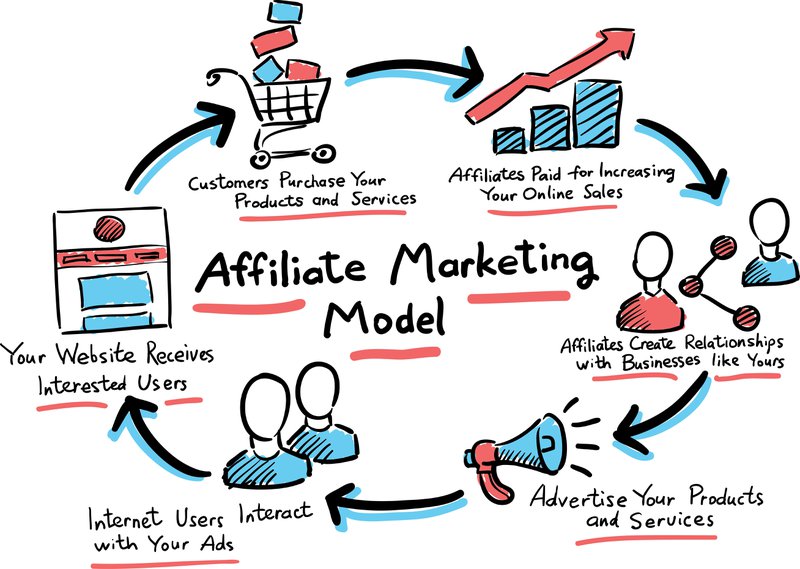Many brands are reengineering their social media marketing strategies to increase their digital reach. This in and of itself poses a key question: affiliate marketing vs. influencer marketing: which one works for their eCommerce?
Should they slowly pour their budgets into affiliate marketing, hoping for clicks, or should they take the plunge and invest in influencer marketing campaigns?
For many brands, rewriting their marketing strategies raises questions about methodology–particularly when deciding between affiliate marketing vs. influencer marketing. Which yields a better ROI? To answer that, let’s first discuss their differences.
What Is Affiliate Marketing?
Over the last decade, eCommerce and Direct-To-Consumer (DTC) brands have generated millions in revenue and countless conversions using digital advertising. Brands increasingly take their marketing efforts to social media as traditional methods like radio and television can’t match online results.

In fact, just last year, Insider Intelligence predicted 2022 eCommerce sales to peak $5 trillion with 20% of that being generated in the U.S. alone. This timeline was sped up from their pre-pandemic estimates. They projected this benchmark would be met by 2024. Now, they’ve forecasted $6 trillion in sales by 2024.
According to Mhojhos Research, the affiliate marketing space is currently worth $17 billion globally, up $4 billion from 2016. Affiliate marketing in the U.S. alone is worth an impressive $6 billion.
Similar to word-of-mouth marketing, this technique focuses on user-generated content (UGC). Your affiliate marketers get paid per sale, so they have the motivation to create and enhance their content for your product. This marketing structure offers a high ROI as you don’t pay for the content itself but for successful conversions.
Affiliates can be influencers, bloggers, websites, or any other social media user with access to your affiliate link. The greatest benefit of having third-party advertising for you is that that content creator’s base already trusts what they say.
While affiliate marketing can be a highly effective method of spiking sales, especially during the holidays or promotional events, it does have limited use cases.
This form of marketing doesn’t focus on more critical, long-term KPIs like brand awareness but rather is a more shortsighted yet cost-effective method of increasing sales. Influencer marketing, on the other hand, is a better way to track KPIs.
What Is Influencer Marketing?
When comparing affiliate marketing vs. influencer marketing, it’s important to note that there’s no universally better option. Instead, their differences are better suited for different purposes.

Both can harness the undeniable power of social media. Just like its affiliate counterpart, influencer marketing has also been on the rise–more than doubling its value to $16.4 billion in 2022.
Brands implementing this marketing strategy team up with a social media influencer to create promotional content. They pay the content creator an upfront, flat fee for the content itself, so they’re not dishing out a percentage of each generated sale. Much like affiliate marketing, it’s typically UGC, made and posted by the influencer speaking directly to their followers.
However, as a rule of thumb, influencers have more sway over their audience and can generate reliable views. Because of this, influencers generally receive higher compensation than affiliates through flat rate fees, product gifting, or commission.
Therefore, brands generally establish KPIs for influencer campaigns that track clickthrough rates, reach, increased SEO, UGC that results from the influencer’s post, and content like follower responses, shares, and likes.
Influencer Types
Choosing the right influencer for your campaign is critical. There are five influencer categories to consider, and each describes a different level of reach based on the number of followers they have:
- Mega-influencers: 1 million+
- Macro-influencers: 500K-1 million
- Mid-tier influencers: 50K-500K
- Micro-influencers:10K-50K
- Nano-influencers: 1K-10K
Factors like your brand size and marketing budget will determine which type of influencer you choose for your campaign. It might seem like larger influencers are better, but micro-influencers often have deeper connections with their smaller audiences. Their audience takes their word more seriously, and they cost less.
Affiliate Marketing vs. Influencer Marketing: Which Is Better for Your eCommerce Store?
Now that we’ve differentiated affiliate marketing vs. influencer marketing picking one is simply a matter of defining your campaign objectives.

For example, if your goals are to generate a sales spike during a special sale or to expand your reach as far as possible, affiliate marketing is the better option for your brand. However, influencer marketing will be more impactful if you want to increase brand awareness on social media platforms.
Simply put, affiliate marketing focuses on generating sales while influencer marketing aims to amplify your brand's social media profile. It's also important to note when comparing affiliate vs. influencer marketing that their similarities might outweigh their differences.
Both harness word-of-mouth marketing principles by implementing UGC to increase the reliability of their messaging. Additionally, both typically generate a high ROI through more personalized outreach.
The Benefits of Affiliate and Influencer Marketing to Your Bottom Line
To further differentiate between affiliate and influencer marketing, let’s look at the benefits of each.

Influencer marketing appears more credible to your audience as your customers already know the creator you’ve partnered with.
Moreover, you can reach your target demographics by partnering with influencers who have a large following among your customer base. However, be careful when picking your influencers, as their behavior will reflect on your brand.
Affiliate marketing is less targeted yet more widespread. You can run affiliate campaigns relatively cheaply and generate an extremely high ROI.
Additionally, it’s easy to scale affiliate campaigns because you do not have to collaborate with individual influencers. However, your sale margins must be high enough to cover affiliate commissions and remain profitable.
The bottom line is that you should use influencer marketing to increase your brand’s profile and affiliate marketing to generate sales.
Maximize Marketing Campaigns With the Right Tools
You can run simultaneous affiliate and influencer campaigns for brands that want to increase awareness and generate more sales. Their unique benefits work best together, making them a winning eCommerce marketing strategy combination. Combining campaigns allows you to achieve your short-term revenue goals and grow your long-term reputability at the same time.
Once you’ve solidified your marketing approach, the final step is to choose the right tools to run your campaign.
Smart Merchandiser makes it easy to set up your eCommerce storefront and optimize conversions through data analytics. Its easy-to-use design helps manage your visual catalog, analytics, inventory, and web design.
Improving customer experience through your digital storefront may be the most important part of your overall eCommerce campaign. Don’t get lost in the noise; reach out to Smart Merchandiser today.



